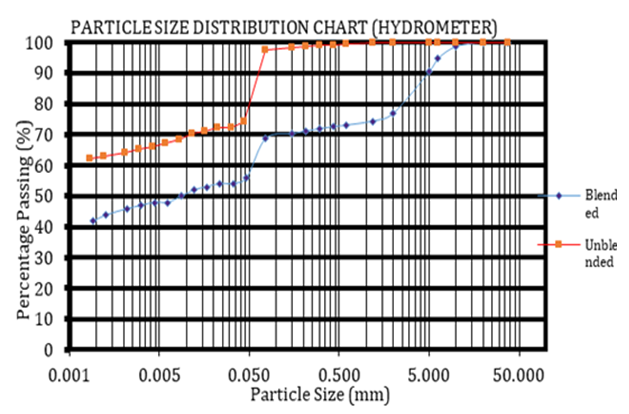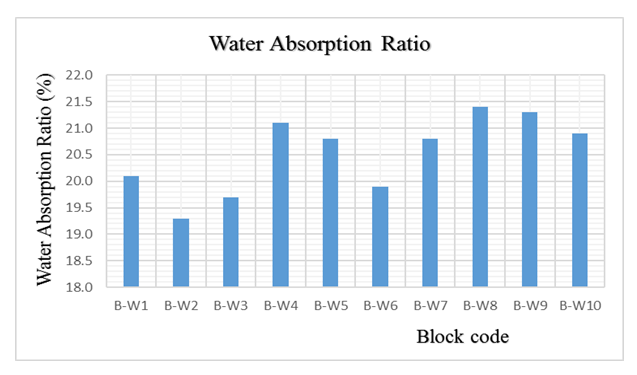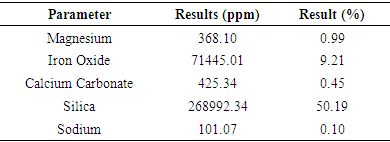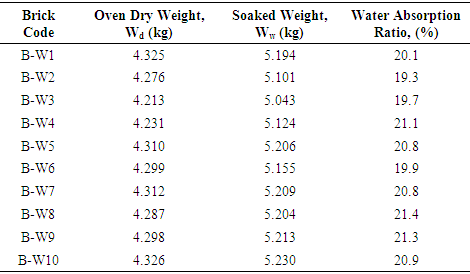-
Paper Information
- Paper Submission
-
Journal Information
- About This Journal
- Editorial Board
- Current Issue
- Archive
- Author Guidelines
- Contact Us
International Journal of Materials Engineering
p-ISSN: 2166-5389 e-ISSN: 2166-5400
2021; 11(1): 6-11
doi:10.5923/j.ijme.20211101.02
Received: Jun. 25, 2021; Accepted: Jul. 17, 2021; Published: Nov. 26, 2021

Investigating Why Burnt Brick Making is Not Carried out in Budondo Sub-county, Jinja District (Uganda)
Harriet Nandugwa1, Manaseh Angurini2, Joel Mubiru1, James Fenekansi Kisule1
1Department of Civil and Building Engineering, Kyambogo University, Kampala, Uganda
2Department of Road Development, Uganda National Roads Authority, Kampala, Uganda
Correspondence to: Joel Mubiru, Department of Civil and Building Engineering, Kyambogo University, Kampala, Uganda.
| Email: |  |
Copyright © 2021 The Author(s). Published by Scientific & Academic Publishing.
This work is licensed under the Creative Commons Attribution International License (CC BY).
http://creativecommons.org/licenses/by/4.0/

This study was conducted to investigate why burnt brick making is not possible/favored in Budondo sub county (Jinja District, Uganda), and how the prevailing problem of temporary housing in the area can be reversed. 36.3% of the dwellings in the sub county are temporary houses, and the outstanding contributor to this big number of temporary houses in the area is due to lack of bricks. For many years, burnt brick making has been absent in the area, which has translated into the use of non-enduring and temporary wall building materials, a high cost of construction; if one is to transport the bricks from the far neighbouring sub counties, low levels of development, low income levels and unemployment among the area youth. Previous attempts to make bricks using local soil in the area have not been successful. Local soil was sampled and taken to the laboratory for analysis of the physical and chemical properties that make soil suitable for making burnt bricks. The soil was found to contain 96.3% silt/clay and 3.7% sand. These soil characteristics when compared to the recommended soil properties, the soil was found unsuitable for brick making. Bricks were made using this soil, and they all failed during curing, due to shrinkage cracking. The characteristics of the local soil were adjusted by blending the soil with sand/gravel soil, in a ratio of 1:2 (local soil sand/gravel fraction). The blended soil was analysed, and found to contain 67% sand, and 37% silt/clay. The characteristics of the blended soil fairly satisfied the recommended soil properties suitable for burnt brick making. Bricks were successfully produced from the blended soil and fired without failing. The fired bricks were tested for Compressive Strength and Water Absorption Ratio (WAR), and the bricks passed the recommended threshold for strength with an average strength of 1.9N/mm2. The average WAR of the bricks was recorded as 20.5%, though this was slightly above the recommended maximum of 20%. It was concluded that the local soil of Budondo Sub-County possesses properties that don’t favour its suitability for burnt brick making, but when the soil is blended with a sand/gravel soil fraction in a ratio of 1:2, the soil acquires properties that favour it for burnt brick making.
Keywords: Burnt Brick, Compressive Strength, Water Absorption Ratio
Cite this paper: Harriet Nandugwa, Manaseh Angurini, Joel Mubiru, James Fenekansi Kisule, Investigating Why Burnt Brick Making is Not Carried out in Budondo Sub-county, Jinja District (Uganda), International Journal of Materials Engineering , Vol. 11 No. 1, 2021, pp. 6-11. doi: 10.5923/j.ijme.20211101.02.
Article Outline
1. Introduction
- Bricks are one of the oldest known building materials dating back to 7000 BC [4]. The earliest brick structures discovered in Nepal is at Maya Devi Temple (Birth place of Lord Buddha) from the 3rd century Before Christ (BC) and Archaeological excavation of Handigaun Satyanarayan Site (1984-88) discovered the bricks in foundation, pavement and wall ranging from 1st century BC. Burnt bricks are the most popular building material, with a current demand estimated at 55 billion per year [3]. Burnt clay bricks are one of the most widely used house building materials in Uganda and elsewhere because of low cost, availability of raw materials, good strength, ease of construction with less supervision, good sound and heat insulation properties, and availability of skilled manpower. The stages in brick making, according to [5], are; winning the clay and preparing it, shaping the bricks, drying the green bricks, and firing the bricks. Earth brick is derived from the disintegration of igneous rocks and a good earth brick should be easily moulded and dried without cracking and warping. According to [12], the chemical composition for a good earth brick making material constitutes of Alumina (Al2O3) or Clay (20-30 percent by weight), Silica (SiO2) or Sand (35-50 percent by weight) and Silt (20-25 percent by weight). As a recommendation to address the minimum percentage of clay, a value of not more than 50 percent by weight should be achieved [6]. For soil to be suitable for brick making, it must meet some requirements in terms of physio-chemical properties. The most direct test method for assessing the suitability of a soil material as a raw material for brick production, used successfully for thousands of years, involves visual inspection and the feel of the soil, and the carrying out of brick making trials [7].The brick making industry employs low technology, manual and “less-efficient” methods such as hand moulding, air drying and open clamp burning, making it cheap. Despite the above advantages associated with brick production, the rural people of Budondo Sub-County (Jinja District) have for many years not been making bricks in the area. With the high poverty rate in the area, it remains that without an intervention directed towards solving this prevailing problem so that people can be able to practice this cheap and highly valuable economic activity, the residents will continue staying in structures (houses) made out of non-enduring and temporal building materials. Additionally, this being a rural area, non-practice of the brick production in the area makes the residents to lose out on the high employment and economic potential that accrues from this activity [8]. Therefore, it’s on this premise that the present research study undertook to investigate and establish facts and technical causes that have restrained the brick making activity in Budondo Sub-County for several years, which has been highlighted as one of the leading contributors to the low standards of living, poor housing conditions, high poverty rates, high unemployment levels and high crime rates among the residents who are jobless and idle, in the area.
2. Materials and Methods
2.1. Study Area
- Budondo Sub-County is one of the rural sub-counties in Jinja District with a total population of 50,508 people as per Uganda Bureau of Statistics, 2012. The population and housing census, 2012 indicated that the number of households by the type of construction materials for the dwelling units was 10,084 in the area, of which 36% had temporal walls and 21.1% had temporal roofs. The current practice, is of people buying burnt bricks from surrounding Sub-Counties of Butagaya, Buwenge and Busedde at a unit price of 90UgShs excluding loading and transportation cost which on average costs 180UgShs up to the construction site. This price is relatively high for a rural poor prospective house owner [8].
2.2. Preparation of Unblended Brick Samples
- The reddish brown sub soil layer below the ground level was excavated manually at longitude 0.496509, latitude 33.20401, elevation 1260.0m and stock piled in a heap and divided in two portions. Drinkable water was added to one portion of the unblended soil sample, and thoroughly mixed manually until a homogeneous paste was observed. The paste was left for 24 hours and then placed into a wooden mould of 220 mm x 110 mm x 150 mm and 30 bricks were moulded. The green bricks were kept under room temperature for three (3) days. The turning of bricks was done after the three (3) days to enable all sides of the bricks to dry uniformly and again left for two (2) more days for further drying. After five (5) days, the bricks were stacked on a raised platform around 300mm above the ground level and in such a way that there is free air circulation between each individual brick to facilitate uniform drying, and the drying process continued for a period totalling to four (4) weeks.
2.3. Preparation of Blended Brick Samples
- The second portion of the stock piled soil was blended with sand and fine gravel, in a ratio of 1:2. Water was added to the blended soil sample, and thoroughly mixed manually until a homogeneous paste was observed. The paste was then placed into a wooden mould of 220 mm x 110 mm x 150 mm and 30 bricks were moulded. The green bricks were kept under room temperature for three (3) days. The turning of bricks was done after the three (3) days to enable all sides of the bricks to dry uniformly and again left for two (2) more days for further drying. After five (5) days, the bricks were stacked on a raised platform around 300mm above the ground level and in such a way that there is free air circulation between each individual brick to facilitate uniform drying. The drying process continued for a period totaling to four (4) weeks. After completion of proper drying, bricks were fired in a local furnace for six (6) hours with little access of free air. All the 30 bricks were successfully fired but during the removal of bricks from the kiln, eight of them had failed due to the burning effect. The remaining 22 bricks were used for the compressive strength test as well as water absorption test.
2.3.1. Strength and Water Absorption
- A total of ten (10) bricks were first marked/coded for the purpose of identification. The dimensions of each brick were taken using a measuring tape and then weighed. A sample brick was carefully centered on the lower platen of the testing machine, ensuring that the load is applied on the top and bottom sides of the brick. The compressive strength test machine was then started and the loading increased at a uniform rate of 3KN/s until the test bricks failed on compression. The maximum load at failure (w) was recorded. The average cross-sectional area (A) in mm2 of the brick’s loaded face was determined from the measured dimensions of the sample bricks as A=L*B. The compressive strength (C) in N/mm2 of each tested brick was obtained by:
 | (1) |
 | (2) |
3. Results and Discussion
3.1. Particle Size Distribution
- The results from the particle size distribution test (sieve analysis) are presented below using a logarithmic graph.From the grading curve above in Figure 1, it is observed that 96.3% of the unblended soil was constituted by the silt-clay fraction and the remaining 3.7% was constituted by fine sand fraction. From this result, the soil was classified as silt-clay. According to [7], soil material suitable for burnt brick production must desirably contain: 25%-50% clay/silt, and 25%-45% sand, and preferably the soil must contain particles of all sizes. This means that the present soil material was not passing this criterion for particle size proportions. This deficient particle size nature of the soil is what prompted the blending of the natural soil with sand and fine gravel, so as to improve the particle grading, such that the soil meets the minimum required criterion.
 | Figure 1. Particle size distribution for initial un-blended soil, Clay gravel and blended soil |
 | Figure 2. Hydrometer analysis results for both blended and unblended samples |
3.2. Atterberg Limits
|
|
|
3.3. Chemical Analysis of Soil
|
|
3.4. Green Bricks
- It was observed that after 3 days, the moulded bricks from un-blended soil started developing cracks and the cracks increased with increase in time period for air drying. At the end of the drying period, twenty-eight (28) bricks had completely failed by cracking and breaking into parts, and only 2 managed to maintain shape, though still with a great number of cracks over the surfaces. Failure of bricks was attributed to high composition of fine soil fraction i.e. 96.3% of silt-clay, which encouraged rapid shrinkage and consequent cracking.
3.5. Compressive Strength Results
|
 | Figure 3. Graphical representation of the compressive strengths of the bricks |
3.6. Water Absorption Results
|
 | Figure 4. Graphical representation of the water absorption of the tested bricks |
4. Conclusions
- The natural soil characteristics results therefore suggest that the soils in Budondo Sub-County are not suitable for burnt brick production without improvement being made to the soil. The local soil was blended with sand and fine gravel from a borrow pit, and this caused improvements in the soil properties, which made it suitable for burnt brick production. The blended soil constituted 67% sand and 37% silt/clay, and also recorded 42.3% as Liquid Limit and 16.9% as Plasticity Index. The improvement in the soil parameters of grading and atterberg limits by blending the soil with a coarser soil fraction of sand and fine gravel led to successful production of bricks which can survive both the drying and burning processes. The bricks survived shrinkage cracking effects due to the counter action against shrinkage provided by the added coarser soil fraction of sand and fine gravel. The compressive strength test recorded an average strength in the range recommended for handmade burnt bricks according to [11]. Meanwhile the water absorption test revealed that water uptake for the bricks is slightly above the recommended according to [10]. It therefore follows that when the local soils of Budondo Sub-County are improved by blending them with a coarser soil fraction of sand/fine gravel in appropriate proportions, they can be used successfully to manufacture handmade burnt bricks fit for construction of local houses. The method in this research should not be generalized but further research should be carried out to investigate the most optimum proportions of the blending soil material that can be appropriately combined with the existing silt/clay soil material of Budondo sub-county, to give bricks of maximum strength, minimum water absorption and acceptable durability. Another direction of research in line with the present study, is a research on other methods for improving the soil so as to acquire properties that suite the soil for production of burnt earth bricks of acceptable mechanical properties, and which can survive shrinkage cracking.
ACKNOWLEDGEMENTS
- We are greatly indebted to Eng. Mwesigwa Leonard of Kampala Capital City Authority (KCCA) for his continuous support and guidance that followed and kept us motivated throughout the writing, proofreading and editing the articles bound to this research. We would also like in a special way to thank the management of Makerere University Materials and Structures Laboratory, for allowing us to carry out our experiments and tests on the bricks. We appreciate the kindness of the technical manager Mr. Ntume William expressed by allowing us unlimited access to the laboratory at a minimum cost. Not forgetting the laboratory technicians for their support when we were carrying out of laboratory experiments. We extend our sincere gratitude to the leadership of Budondo Sub-County especially the Local Council three (LCIII), Local Council two (LCII) and the Local Council one (LCI) together with security clearance from the Sub-County police office for granting us access to obtain soil samples, blending materials and making bricks. Lastly, we thank the local people of Budondo for offering labour in excavation of soil, preparation of materials and making the different bricks of interest ready for testing.
 Abstract
Abstract Reference
Reference Full-Text PDF
Full-Text PDF Full-text HTML
Full-text HTML





